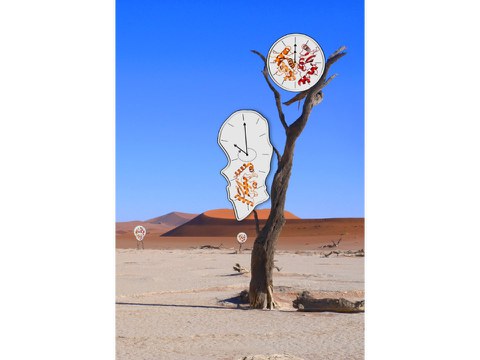Oct 21, 2020
It’s all about the right balance

Surrealistic take on the enzyme UBE2S, which regulates its lifetime by switching between a monomeric and a dimeric state.
Collaborative work of research groups at the University of Würzburg and the TU Dresden has provided important new insights for cancer research. During cell division specific target proteins have to be turned over in a precisely regulated manner. To this end specialized enzymes label the target proteins with signaling molecules. However, the enzymes involved in this process can also label themselves, thus initiating their own degradation. In a multidisciplinary approach, the researchers identified a mechanism of how enzymes can protect themselves from such self-destruction and maintain sufficient concentrations in the cell. These results have been published in the latest issue of Science Signaling.
Vital functions of the multicellular organisms, such as growth, development, and tissue regeneration, depend on the precisely controlled division of cells. A failure in the underlying control mechanisms can lead to cancer. A team of researchers led by Dr. Sonja Lorenz from the Rudolf Virchow Center - Center for Integrative and Translational Bioimaging at the University of Würzburg and by Dr. Jörg Mansfeld from the Biotechnology Center (BIOTEC) at the Technical University of Dresden discovered a new mechanism that modulates cell division.
Ubiquitination – a central regulatory element
A critical step in cell division is the distribution of the genetic information evenly between the daughter cells. This process is controlled by a large protein complex, the anaphase-promoting complex/cyclosome (APC/C), which labels proteins with a signaling molecule known as “ubiquitin”. The ubiquitin label functions essentially as a molecular postal code, targeting labeled proteins to the cellular protein degradation machinery. To allow for the efficient and precise labeling of target proteins, the APC/C works together with an ubiquitin-conjugating enzyme, UBE2S. However, UBE2S also has the ability to modify itself with ubiquitin, thus initiating its own degradation. This ability applies to ubiquitination enzymes in general. “This raises the fundamental question of how ubiquitination enzymes find the right balance between labeling their targets and labeling themselves to ensure that sufficient quantities of the enzymes are available in the cell,” says Sonja Lorenz.
Switching between active and inactive states
The new study provides an answer to this question by showing that UBE2S can adopt an inactive state in which it is unable to label itself with ubiquitin. "When UBE2S forms a dimer, i.e., two molecules pair with each other, they become inactive and protected from self-destruction," says Jörg Mansfeld. The scientists suggest that this mechanism ensures that a stable cellular pool of UBE2S is preserved and re-activated when required. The cell can thus control the ratio of active and inactive UBE2S to fine tune cell division. These findings provide a structural framework for the development of new cancer-therapeutic strategies and drug discovery.
Ubiquitin research in the Lorenz and Mansfeld groups
The current study presents the second successful, published collaboration of the Lorenz and Mansfeld groups on the regulation of UBE2S. Notably, both research articles were featured in dedicated commentary pieces.
The research group of Sonja Lorenz investigates the structural basis of the ubiquitin system, which controls almost all cellular processes. She is particularly interested in revealing the factors that account for the enormous specificity of ubiquitin as a molecular signal. Her group combines high-resolution structural techniques that yield atomic-resolution views with biochemical, biophysical, and cell-based methods. The Lorenz laboratory is funded by the Emmy Noether program of the German Research Foundation (DFG) and an ubiquitin-focused Research Training Group (GRK2243; DFG), which Sonja Lorenz represents as a co-speaker. Sonja Lorenz is also a founding member of the Mildred Scheel Early Career Center (German Cancer Aid) in Würzburg and has been engaged with transregional ubiquitin initiatives. In 2018 Dr. Lorenz was accepted into the highly selective EMBO Young Investigator Program. A member of the Lorenz laboratory, Anna Liess was part of the Würzburg Graduate School of Life Sciences and the GRK2243 and successfully defended her PhD thesis in 2020.
Jörg Mansfeld and his research group focus on ubiquitination and other protein modifications. The Mansfeld group uses cell biology and biochemical methods to investigate the role of these modifications in the decision whether a cell continues to divide or stops, in order to fulfill a specialized function. The Mansfeld group is funded by the ERC under the European Union’s Horizon 2020 research and Innovation Program as well as Emmy Noether and project grants of the DFG. Alena Kučerová is a PhD student of the Dresden International Graduate School for Biomedicine and Bioengineering (DIGS-BB) and was supported by a DIGS-BB Fellowship.
Publication:
Anna KL Liess, Alena Kucerova, Kristian Schweimer, Dörte Schlesinger, Olexandr Dybkov, Henning Urlaub, Jörg Mansfeld, and Sonja Lorenz: Dimerization regulates the human APC/C-associated ubiquitin-conjugating enzyme UBE2S. Science Signaling (October 2020)
doi: https://doi.org/10.1126/scisignal.aba8208
For more information please contact:
Dr. Sonja Lorenz (AG Lorenz, Rudolf Virchow Center)
Tel: +49 (0)931 31-80526,
Dr. Judith Flurer (Pressestelle, Rudolf Virchow Center)
Tel: +49 (0)931 31-85822,
Dr. Jörg Mansfeld (Mansfeld Group, BIOTEC, TU Dresden)
Tel. +49 (0)351 463 40120,
The Rudolf-Virchow Center is a central institution of the University of Würzburg. The research groups investigate the key proteins that are vital for the function of cells and thus for health and disease.
https://www.uni-wuerzburg.de/en/rvz/home/
The Biotechnology Center (BIOTEC) was founded in 2000 as a central scientific unit of the TU Dresden with the goal of combining modern approaches in molecular and cell biology with the traditionally strong engineering in Dresden. Since 2016, the BIOTEC is part of the central scientific unit “Center for Molecular and Cellular Bioengineering” (CMCB) of the TU Dresden. The BIOTEC is fostering developments in research and teaching within the Molecular Bioengineering research field and combines approaches in cell biology, biophysics and bioinformatics. It plays a central role within the research priority area Health Sciences, Biomedicine and Bioengineering of the TU Dresden.
www.tu-dresden.de/biotec
www.tu-dresden.de/cmcb
